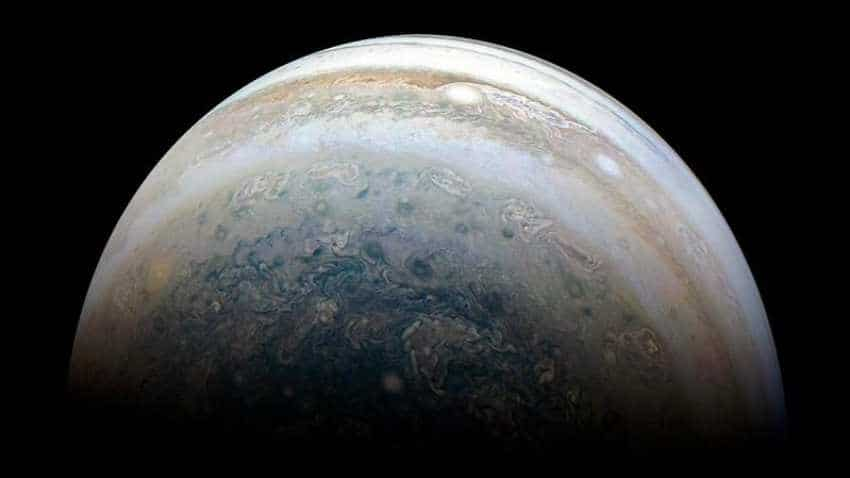Jupiter still reeling from head-on collision 4.5bn years ago
The research team ran thousands of computer simulations and found that a fast-growing Jupiter can have perturbed the orbits of nearby "planetary embryos," protoplanets that were in the early stages of planet formation.

A colossal, head-on collision between Jupiter and a still-forming planet in the early solar system, about 4.5 billion years ago, has left Jupiter`s core less dense and more extended that expected, say researchers.
Even if this impact happened 4.5 billion years ago, "it could still take many, many billions of years for the heavy material to settle back down into a dense core under the circumstances suggested by the paper", said researchers who analysed readings from NASA`s Juno spacecraft.
Astronomers from Rice University and China`s Sun Yat-sen University say their head-on impact scenario can explain Juno`s previously puzzling gravitational readings.
"This is puzzling. It suggests that something happened that stirred up the core, and that`s where the giant impact comes into play," said Rice astronomer and study co-author Andrea Isella in a paper published in the journal Nature.
Isella said leading theories of planet formation suggest Jupiter began as a dense, rocky or icy planet that later gathered its thick atmosphere from the primordial disk of gas and dust that birthed our sun.
Isella said he was skeptical when study lead author Shang-Fei Liu first suggested the idea that the data could be explained by a giant impact that stirred Jupiter`s core, mixing the dense contents of its core with less dense layers above.
The research team ran thousands of computer simulations and found that a fast-growing Jupiter can have perturbed the orbits of nearby "planetary embryos," protoplanets that were in the early stages of planet formation.
The collision scenario became even more compelling after Liu ran 3D computer models that showed how a collision would affect Jupiter`s core.
"Because it`s dense, and it comes in with a lot of energy, the impactor would be like a bullet that goes through the atmosphere and hits the core head-on," Isella said.
"Before impact, you have a very dense core, surrounded by atmosphere. The head-on impact spreads things out, diluting the core."
"The only scenario that resulted in a core-density profile similar to what Juno measures today is a head-on impact with a planetary embryo about 10 times more massive than Earth," Liu said.
The Juno mission was designed to help scientists better understand Jupiter`s origin and evolution.
The spacecraft, which launched in 2011, carries instruments to map Jupiter`s gravitational and magnetic fields and probe the planet`s deep, internal structure.
Get Latest Business News, Stock Market Updates and Videos; Check your tax outgo through Income Tax Calculator and save money through our Personal Finance coverage. Check Business Breaking News Live on Zee Business Twitter and Facebook. Subscribe on YouTube.
RECOMMENDED STORIES

Rs 3,500 Monthly SIP for 35 years vs Rs 35,000 Monthly SIP for 16 Years: Which can give you higher corpus in long term? See calculations

Power of Compounding: How long it will take to build Rs 5 crore corpus with Rs 5,000, Rs 10,000 and Rs 15,000 monthly investments?

SBI 444-day FD vs PNB 400-day FD: Here's what general and senior citizens will get in maturity on Rs 3.5 lakh and 7 lakh investments in special FDs?

SCSS vs FD: Which guaranteed return scheme will give you more quarterly income on Rs 20,00,000 investment?
05:01 PM IST










 King of Moons: 12 new moons found around Jupiter, most in solar system
King of Moons: 12 new moons found around Jupiter, most in solar system Budget 2023: Why investors should keep an eye on railway stocks ahead of Union Budget
Budget 2023: Why investors should keep an eye on railway stocks ahead of Union Budget  Earth-Jupiter rendezvous! Gas giant's closet approach in 59 years on September 26 - How to watch
Earth-Jupiter rendezvous! Gas giant's closet approach in 59 years on September 26 - How to watch  Jupiter, its moons captured by NASA's James Webb Space Telescope like never before | Photos
Jupiter, its moons captured by NASA's James Webb Space Telescope like never before | Photos Jupiter-Saturn alignment: Earthlings treated to rare Great Conjunction
Jupiter-Saturn alignment: Earthlings treated to rare Great Conjunction